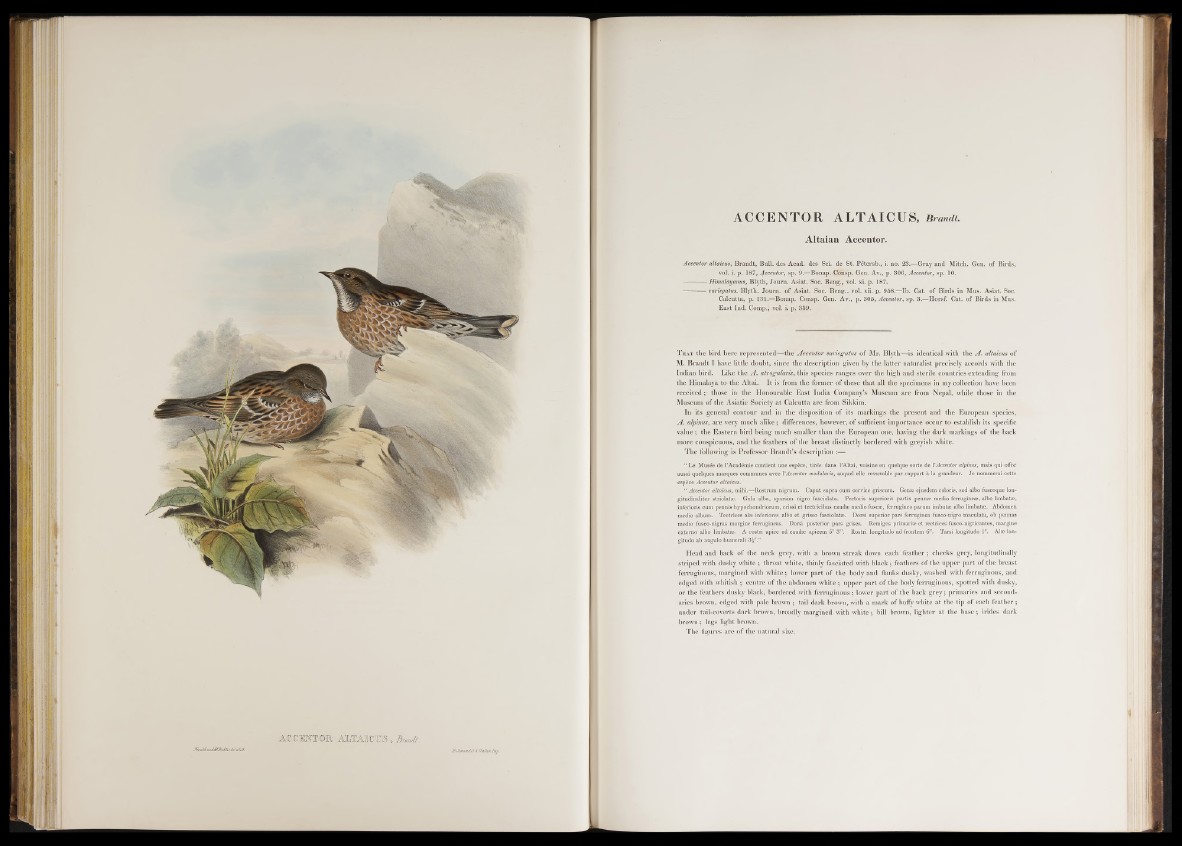
AC C EN T « AIiTAICCS. Brandt.
ACCENTOR ALTAICUS, Brandt.
Altaian Accentor.
Accentor altaicus, Brandt, Bull, des Acad, des Sei. de St. Pltersb., i. no. 23.—Gray and Mitch. Gen. of Birds,
vol. i. p. 187, Accentor, sp. 9.—Bonap. Cöhsp. Gen. Av., p. 306, Accentor, sp. 10.
---------- Himalayanus, Blyth, Joura. Asiat. Soc. Beng., vol. xi. p. 187.
—--------variegatus, Blyth, Joum. of Asiat. Soc. Beng., vol. xii. p. 958.—lb. Cat. of Birds in Mus. Asiat. Soc.
Calcutta, p. 131.—Bonap. Consp. Gen. A v., p. 305, Accentor, sp. 3.—Horsf. Cat. of Birds in Mus.
East Ind. Comp.* vol. i. p. 359.
T h a t the bird here represented— the Accentor variegatus of Mr. Blyth— is identical with the A . altaicus of
M. Brandt I have little doubt, since the description given by the latter naturalist precisely accords with the
Indian bird. Like the A . atrogularis, this species ranges over the high and sterile countries extending from
the Himalaya to the Altai. It is from the former o f these that all the specimens in my collection have been
received;« those in the Honourable East India Company’s Museum are from Nepal, while those in the
Museum of the Asiatic Society a t Calcutta are from Sikkim.
In its general contour and in the disposition of its markings the present and the European species,
A . alpinus, are very much alike ; differences, however, o f sufficient importance occur to establish its specific
value ; the Eastern bird being much smaller than the European one, having the dark markings o f the back
more conspicuous, and the feathers of the breast distinctly bordered with greyish white.
The following is Professor Brandt’s description :—
“ Le Musée de l’Académie contient une espèce, tirée dans l’Altai, voisine en quelque sorte de 1’Accentor alpinus, mais qui offrë
aussi quelques marques communes avec 1 'Accentor modularis, auquel elle ressemble par rapport à la grandeur. Je nommerai cette
espèce Accentor altaicus.
“ Accentor altaicus, mihi.—Rostrum nigrum. Caput supra cum cervice griseum. Genæ ejusdem coloris, sed albo fuscoque lon-
gitudinaliter striolatæ. Gula alba, sparsim nigro fasciolata. Pectoris superioris partis pennæ medio ferrugineæ, albo limbatæ,
inferioris cum pennis hypochondriorum, crissi et tectricibus caudæ medio fuscæ, ferrugineo parum imbutæ albo limbatæ. Abdomen
medio album. Tectrices alæ inferiores albo et griseo fasciolatæ. Dorsi superior pars ferruginea fusco-nigro maculata, ob pennas
medio fusco-nigras margine ferrugineas. Dorsi posterior pars grisea. Remiges primariæ et rectrices fusco-nigricantes, margine
externo albo limbatæ. A rostri apice ad caudæ apicem 5" 3"'. Rostri longitudo ad frontem 6"'. Tarsi longitudo 1". Alæ lon-
gitudo ab angulo humer ali 3^".”
Head and back of the neck grey, with a brown streak down each feather ; cheeks grey, longitudinally
striped with dusky white ; throat white, thinly fasciated with black ; feathers o f the upper part of the breast
ferruginous, margined with white ; lower part of the body and flanks dusky, washed with ferruginous, and
edged with whitish ; centre of the abdomen white ; upper part of the body ferruginous, spotted with dusky,
or the feathers dusky black, bordered with ferruginous ; lower p art of the back grey ; primaries and secondaries
brown, edged with pale brown ; tail dark brown, with a mark of bufly white a t the tip of each feather ;
under tail-coverts dark brown, broadly margined with white ; bill brown, lighter a t the base ; irides dark
brown ; legs light brown.
The figures are o f the natural size.